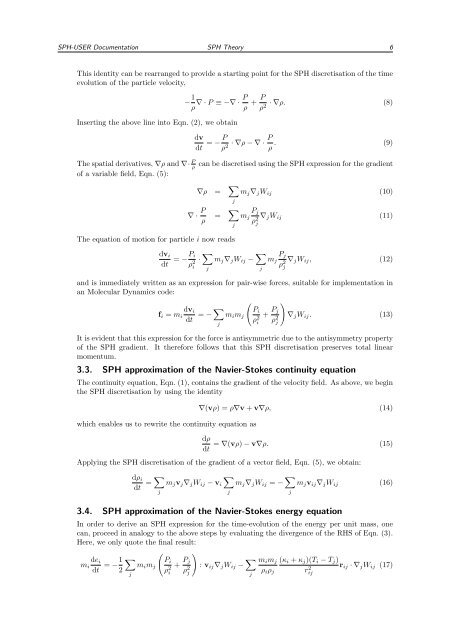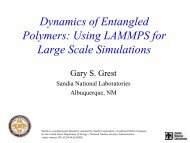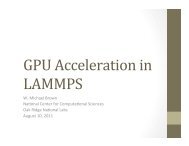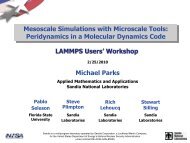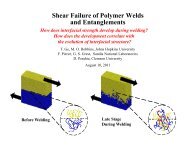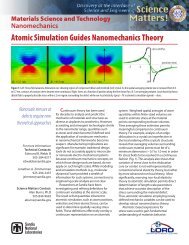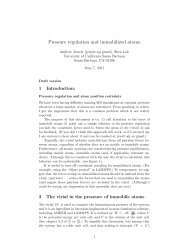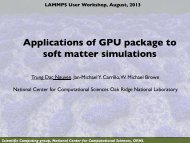this user's guide - Lammps
this user's guide - Lammps
this user's guide - Lammps
You also want an ePaper? Increase the reach of your titles
YUMPU automatically turns print PDFs into web optimized ePapers that Google loves.
SPH-USER Documentation SPH Theory 6<br />
This identity can be rearranged to provide a starting point for the SPH discretisation of the time<br />
evolution of the particle velocity,<br />
Inserting the above line into Eqn. (2), we obtain<br />
The spatial derivatives, ∇ρ and ∇· P<br />
ρ<br />
of a variable field, Eqn. (5):<br />
− 1 ρ ∇ · P ≡ −∇ · P<br />
ρ + P · ∇ρ. (8)<br />
ρ2 dv<br />
dt = − P ρ 2 · ∇ρ − ∇ · P<br />
ρ . (9)<br />
can be discretised using the SPH expression for the gradient<br />
∇ρ = ∑ j<br />
m j ∇ j W ij (10)<br />
∇ · P<br />
ρ<br />
= ∑ j<br />
P j<br />
m j<br />
ρ 2 ∇ j W ij (11)<br />
j<br />
The equation of motion for particle i now reads<br />
dv i<br />
dt = −P i<br />
ρ 2 i<br />
· ∑<br />
m j ∇ j W ij − ∑<br />
j<br />
j<br />
P j<br />
m j<br />
ρ 2 ∇ j W ij , (12)<br />
j<br />
and is immediately written as an expression for pair-wise forces, suitable for implementation in<br />
an Molecular Dynamics code:<br />
dv i<br />
f i = m i<br />
dt = − ∑ ( )<br />
P i<br />
m i m j<br />
ρ 2 + P j<br />
j<br />
i ρ 2 ∇ j W ij . (13)<br />
j<br />
It is evident that <strong>this</strong> expression for the force is antisymmetric due to the antisymmetry property<br />
of the SPH gradient. It therefore follows that <strong>this</strong> SPH discretisation preserves total linear<br />
momentum.<br />
3.3. SPH approximation of the Navier-Stokes continuity equation<br />
The continuity equation, Eqn. (1), contains the gradient of the velocity field. As above, we begin<br />
the SPH discretisation by using the identity<br />
which enables us to rewrite the continuity equation as<br />
∇(vρ) = ρ∇v + v∇ρ, (14)<br />
dρ<br />
dt<br />
= ∇(vρ) − v∇ρ. (15)<br />
Applying the SPH discretisation of the gradient of a vector field, Eqn. (5), we obtain:<br />
dρ i<br />
dt = ∑ j<br />
∑<br />
m j v j ∇ j W ij − v i m j ∇ j W ij = − ∑<br />
j<br />
j<br />
3.4. SPH approximation of the Navier-Stokes energy equation<br />
m j v ij ∇ j W ij (16)<br />
In order to derive an SPH expression for the time-evolution of the energy per unit mass, one<br />
can, proceed in analogy to the above steps by evaluating the divergence of the RHS of Eqn. (3).<br />
Here, we only quote the final result:<br />
m i<br />
de i<br />
dt = −1 2<br />
∑<br />
j<br />
(<br />
P i<br />
m i m j<br />
ρ 2 + P j<br />
i ρ 2 j<br />
)<br />
: v ij ∇ j W ij − ∑ j<br />
m i m j (κ i + κ j )(T i − T j )<br />
r ij · ∇ j W ij (17)<br />
ρ i ρ j<br />
r 2 ij


